Zombies are real!
This is no Halloween make-believe story. Real zombies are out there — maybe in your own backyard!

It may be fun to dress up like a zombie for Halloween, but real zombies do exist. They’re just not human. They’re animals under the mind control of parasites.
treasuredragon/istockphoto
A zombie crawls through the forest. When it reaches a good spot, it freezes in place. A stalk slowly grows from its head. The stalk then spews out spores that spread, turning others into zombies.
This is no Halloween story about the zombie apocalypse. It’s all true. The zombie isn’t a human, though. It’s an ant. And the stalk that emerges from its head is a fungus. Its spores infect other ants, which lets the zombie cycle begin anew.
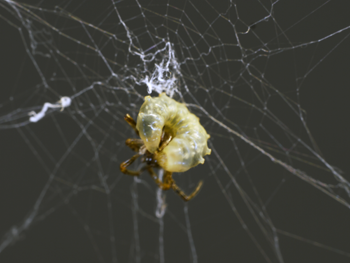
In order to grow and spread, this fungus must hijack an ant’s brain. However weird this might seem, it isn’t all that unusual. The natural world is full of zombies under mind control. Zombie spiders and cockroaches babysit developing wasp larvae — until the babies devour them. Zombie fish flip around and dart toward the surface of the water, seeming to beg for birds to eat them. Zombie crickets, beetles and praying mantises drown themselves in water. Zombie rats are drawn to the smell of the pee of cats that may devour them.
All of these “zombies” have one thing in common: parasites. A parasite lives inside or on another creature, known as its host. A parasite may be a fungus, a worm or another tiny creature. All parasites eventually weaken or sicken their hosts. Sometimes, the parasite kills or even eats its host. But death of the host isn’t the freakiest goal. A parasite might get its host to die in a certain place, or be eaten by a certain creature. In order to accomplish these tricks, some parasites have evolved the ability to hack into the host’s brain and influence its behavior in very specific ways.
How do parasites turn insects and other animals into the walking almost-dead? Every parasite has its own method, but the process usually involves altering chemicals within the victim’s brain. Researchers are working hard to identify which chemicals are involved and how they end up so bizarrely altering their host’s behavior.
Brains, brains! Ant brains!
A fungus doesn’t have a brain. And worms and single-celled critters obviously aren’t very smart. Yet somehow they still control the brains of larger, and smarter, animals.
“It blows my mind,” says Kelly Weinersmith. She is a biologist who studies parasites at Rice University in Houston, Texas. She is particularly interested in “zombie” creatures. True zombies, she points out, aren’t exactly like the type you find in horror stories. “In no way are these animals coming back from the dead,” she says. Most real zombies are doomed to die — and some have very little control over their actions.
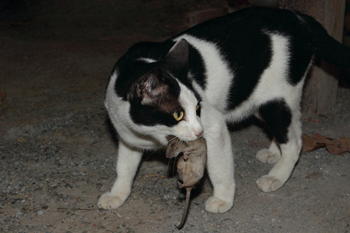
The horsehair worm, for instance, needs to emerge in water. To make this happen, it forces its insect host to leap into a lake or swimming pool. Often, the host drowns.
Toxoplasma gondii (TOX-oh-PLAZ-ma GON-dee-eye) is a single-celled creature that can only complete its life cycle inside a cat. But first, this parasite must live for a time in a different animal, such as a rat. To ensure this part-time host gets eaten by a cat, the parasite turns rats into cat-loving zombies.
In Thailand, a species of fungus — Ophiocordyceps — can force an ant to climb almost exactly 20 centimeters (about 8 inches) up a plant, to face north and then to bite down on a leaf. And it makes the ant do this when the sun is at its highest point in the sky. This provides ideal conditions for the fungus to grow and release its spores.
Biologist Charissa de Bekker wants to better understand how that fungus exerts that mind control over the ants. So she and her team have been studying a species related to the Ophiocordyceps fungus in Thailand. This U.S. cousin is a fungus native to South Carolina. It, too, forces ants to leave their colonies and climb. These ants, though, bite down on twigs instead of leaves. This is likely due to the fact that trees and plants in this state lose their leaves in the winter.
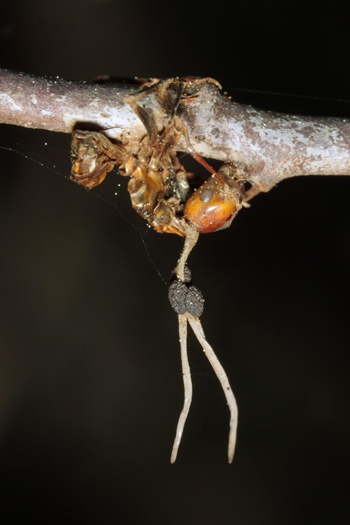
De Bekker began these studies at Pennsylvania State University in University Park. There, her team infected a few species of ant with the South Carolina fungus. The parasite could kill all of the different ants she introduced to it. But the fungus made plant-climbing zombies only out of the species that it naturally infects in the wild.
To figure out what was going on, de Bekker’s team collected new, uninfected ants of each species. Then, the researchers removed the insects’ brains. “You use forceps and a microscope,” she says. “It’s sort of like that game Operation.”
The researchers kept the ant brains alive in small Petri dishes. When the fungus was exposed to its favorite brains (that is, ones from the ants that it naturally infects in the wild), it released thousands of chemicals. Many of these chemicals were completely new to science. The fungus also released chemicals when exposed to unfamiliar brains. These chemicals, however, were completely different. The researchers published their results in 2014.
The experiments at Penn State by de Bekker’s team were the first to create ant zombies in the lab. And the researchers only succeeded after setting up artificial 24-hour cycles of light and darkness for the zombies and their parasites.
It will take more work to learn how the parasite’s chemicals lead to zombie behavior in ants. “We are very much in the beginning of trying to figure this out,” says de Bekker. She now studies ant zombies at Ludwig Maximilian University in Munich, Germany. There, she is now probing how that daily cycle of sunlight and darkness affects zombification.
Soul-sucking wasps
Of all parasites, wasps know some of the creepiest tricks. One wasp, Reclinervellus nielseni, lays its eggs only on orb-weaving spiders. When a wasp larva hatches, it slowly sips its host’s blood. The spider stays alive long enough to spin a web. But not just any web. It spins a nursery of sorts for the wriggly, worm-like wasp baby stuck to its back.
The spider will even break down its old web to start a new one for the larva. “The [new] web is stronger than the normal web,” explains Keizo Takasuka. He studies insect behavior and ecology at Kobe University in Japan. When the web is done, the larva eats its spider host.
Now the larva spins a cocoon in the middle of the web. The extra strong threads most likely help the larva stay safe until it emerges from its cocoon 10 days later.
Story continues after video.
The jewel wasp puts an insect on the menu it serves up to its young: cockroach. But before a wasp larva can chow down, its mother needs to catch a bug that’s twice her size. To do this, says Frederic Libersat, “she transforms the cockroach into a zombie.” Libersat is a neurobiologist who studies how the brain controls behavior. He works at Ben Gurion University in Beer-Sheva, Israel.
The jewel wasp’s sting takes away a cockroach’s ability to move on its own. But it follows like a dog on a leash when the wasp pulls on its antenna. The wasp leads the cockroach to her nest and lays an egg on it. Then she leaves, sealing the egg inside the nest with its dinner. When the egg hatches, the larva slowly devours its host. Being a zombie, this cockroach never tries to fight back or escape.
This scenario is so creepy that biologists named a similar wasp Ampulex dementor — after a supernatural enemy in the Harry Potter series. In these books, dementors can devour people’s minds. This leaves the victim alive but without a self or soul. (Although A. dementor is a close relative of the jewel wasp, Libersat notes that researchers have not yet confirmed that it also turns cockroaches or any other insect into mindless slaves.)
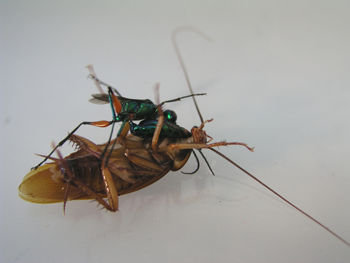
Libersat’s group has focused its research on figuring out what the jewel wasp does to the cockroach mind. The mother jewel wasp performs something like brain surgery. She uses her stinger to feel around for the right part of her victim’s brain. Once found, she then injects a zombifying venom.
When Libersat removed the targeted parts of a roach’s brain, the wasp would feel around what was left of the roach’s brain with her stinger for 10 to 15 minutes. “If the brain was present, [the wasp] would take less than a minute,” he notes. This shows that the wasp can sense the right place to inject its poison.
That venom might interfere with a chemical in the roach’s brain called octopamine, Libersat reports. This chemical helps the cockroach stay alert, walk and perform other tasks. When researchers injected a substance similar to octopamine into zombie cockroaches, the insects again began walking.
Libersat cautions, however, that this is likely just one piece of the puzzle. There is still work to do to understand the chemical process happening in the cockroach’s brain, he says. But Weinersmith, who was not involved in the research, notes that Libersat’s team has worked out this chemical process in more detail than is available for most types of zombie mind control.
Brain worms
Weinersmith’s specialty is zombie fish. She studies California killifish infected with a worm called Euhaplorchis californiensis (YU-ha-PLOR-kis CAL-ih-for-nee-EN-sis). A single fish may have thousands of these worms living on the surface of its brain. The wormier the brain, the more likely the fish is to behave strangely.
“We call them zombie fish,” she says, but admits that they are less like zombies than the ants, spiders or cockroaches. An infected fish will still eat normally and stay in a group with its pals. But it also tends to dart toward the surface, twist its body around or rub against rocks. All of these actions make it easier for birds to see the fish. Indeed, it’s almost like the infected fish wants to get eaten.
And that’s precisely the point, says Weinersmith — for the worm. This parasite can only reproduce inside a bird. So it alters the fish’s behavior in a way that attracts birds. Infected fish are 10 to 30 times more likely to get eaten. That’s what Weinersmith’s colleagues Kevin Lafferty of the University of California, Santa Barbara and Kimo Morris of Santa Ana College in California discovered.
Weinersmith now is working with Øyvind Øverli at the Norwegian University of Life Sciences, in As. They are studying the chemical processes behind the zombie fish’s bird-seeking behavior. So far, it seems that zombie fish may be less stressed out than their normal cousins. Researchers know what chemical changes should happen to a killifish brain when something, such as the sight of a bird on the prowl, stresses it out. But in a zombie fish’s brain, these chemical changes don’t seem to occur.
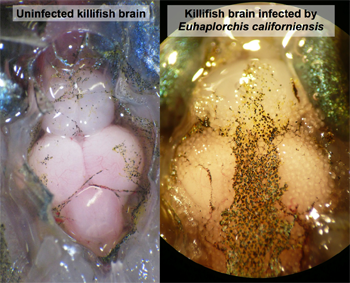
It’s as if the fish notices the hunting bird but doesn’t get freaked out as it should. “We need to do further studies to confirm this is true,” says Weinersmith. Her group plans to analyze the chemicals in the brains of infected fish, then try to recreate the zombie effect in normal fish.
Success won’t come easily. Zombie mind control is a complicated matter. Parasites have developed their control of other creatures’ brains over millions of years of evolution. Scientists have found fossil evidence of fungus-controlled ants dating back 48 million years. Over this long period, she says, “the fungus ‘learned’ a lot more about how the ant’s brain works than human scientists have.”
But scientists are starting to catch up. “Now we can ask [the parasites] what they’ve learned,” quips Weinersmith.
Ant brains may be much simpler than human brains, but the chemistry going on inside them isn’t all that different. Figuring out the secrets of zombie mind control in bugs could help neuroscientists understand more about the links between the brain and behavior in people.
Eventually, this work could lead to new medicines or therapies for human brains. We just have to hope that a mad scientist won’t go out and start making human zombies!







